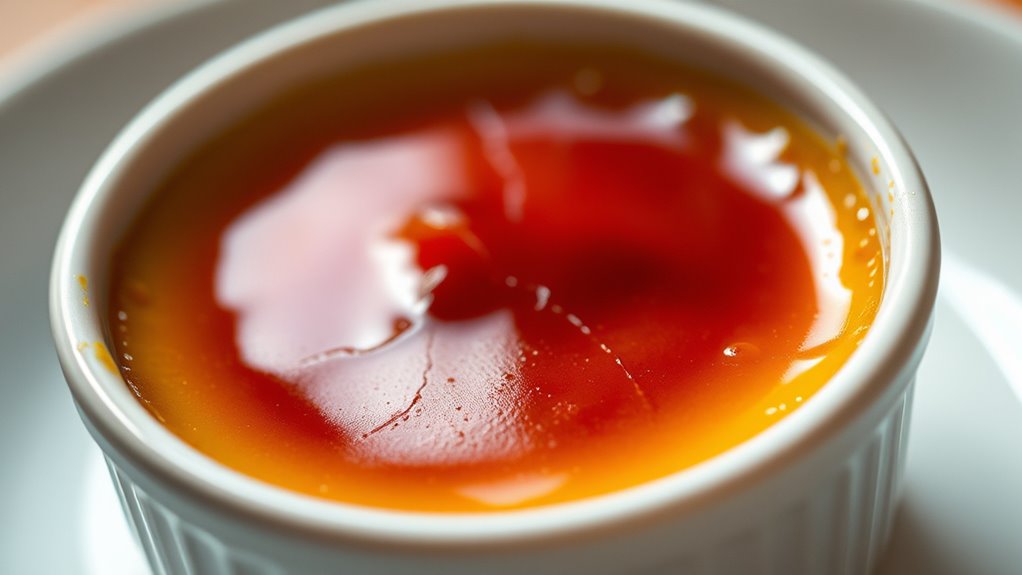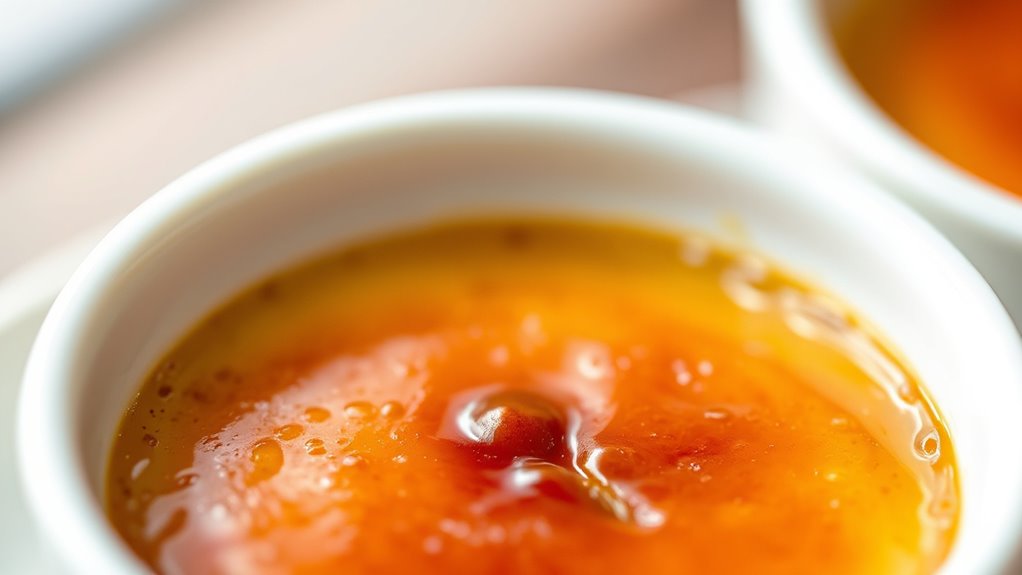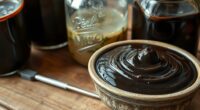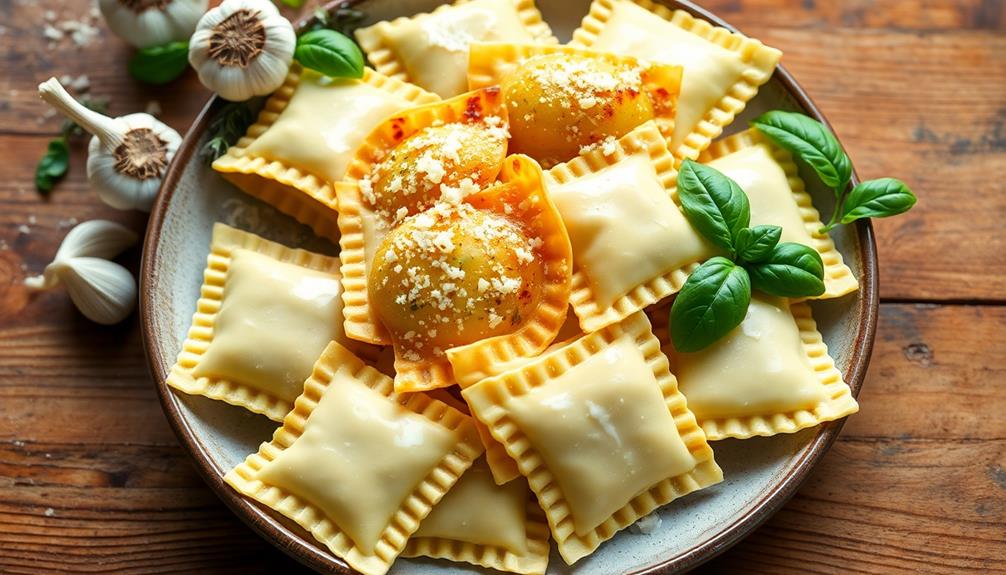To achieve silky crème brûlée every time, keep your oven temperature between 300°F and 325°F. This gentle heat helps your custard cook evenly, preventing curdling or undercooking. Using an oven thermometer guarantees you stay within this range for perfect texture. Maintaining consistent temperature is key to a smooth, creamy dessert with a beautiful caramelized crust. If you want to master this technique, you’ll find more tips below.
Key Takeaways
- Maintain an oven temperature between 300°F and 325°F for gentle, even custard baking.
- Use an oven thermometer to ensure precise temperature control during baking.
- Preheat the oven thoroughly to promote consistent heat and prevent uneven cooking.
- Keep the custard within the ideal temperature range to avoid curdling or runny textures.
- Proper temperature ensures even caramelization of the sugar topping for a flawless crust.

Have you ever wondered what the perfect temperature for crème brûlée is? Achieving that silky, smooth custard with a perfectly caramelized sugar top hinges on understanding just a few key factors—especially oven temperature. When you bake crème brûlée, the goal is to gently cook the custard until it’s just set, with a delicate, creamy texture that melts in your mouth. If the oven temperature is too high, you risk overcooking the custard, causing it to curdle or develop a grainy texture. Too low, and it might not set properly, leaving you with a runny dessert. The sweet spot usually falls between 300°F and 325°F, which provides enough heat to cook the custard evenly without risking overcooking. Using an oven thermometer can help you maintain this precise temperature, ensuring consistent results every time. Proper temperature control during baking is essential for achieving the ideal custard consistency and texture. Understanding sugar caramelization is essential for that signature brûlée finish. When you sprinkle sugar on top of the custard and then use a torch or broiler, the heat causes the sugar to caramelize quickly, forming that beautiful, brittle crust. But if the oven temperature isn’t right during baking, the underlying custard may not develop the right texture, and the caramelized sugar might not sit properly on the surface. Maintaining consistent oven temperatures is key to evenly caramelizing the sugar and achieving a flawless crust. Additionally, temperature stability in your oven can significantly impact the evenness of your caramelization process. For best results, preheat your oven thoroughly so it reaches and maintains the ideal temperature. This consistency helps the sugar melt evenly and caramelize uniformly, creating that glossy, golden-brown topping that’s essential to a perfect crème brûlée.
Frequently Asked Questions
Can I Use a Microwave Instead of an Oven?
You might wonder if you can use a microwave instead of an oven for crème brûlée. While microwave adaptation offers quick cooking, it’s not ideal for achieving the perfect silky texture. Microwaves can heat unevenly, risking overcooking or curdling the custard. For best results, stick with the oven, but if you’re in a hurry, carefully use short bursts on low power, and keep a close eye to prevent overcooking.
How Do Altitude Changes Affect Temperature?
Altitude baking impacts your recipes because higher altitudes cause air pressure to drop, which affects how heat transfers. You’ll need to modify temperature and baking time accordingly. For example, at higher altitudes, you should increase the oven temperature slightly and reduce baking time to prevent overcooking. Proper temperature adjustment ensures your crème brûlée or other baked goods turn out perfectly, even when altitude changes challenge your usual baking process.
Is It Safe to Eat Undercooked Crème Brûlée?
You should avoid eating undercooked crème brûlée because food safety is vital to prevent illness. Undercooked custard may contain harmful bacteria, risking your health. Additionally, the texture consistency won’t be ideal if it’s undercooked, resulting in a runny or grainy feel instead of silky smoothness. Always make sure your crème brûlée is properly cooked to a safe temperature, providing both safety and that perfect, velvety texture you want.
Can I Make It Ahead of Time and Reheat?
You can definitely make crème brûlée ahead of time and reheat it later. Use make ahead tips like covering the custards tightly and storing them in the fridge for up to two days. When reheating, opt for gentle methods like warming in a water bath or in the oven at a low temperature to prevent curdling. This way, you preserve the silky texture and enjoy a perfectly creamy dessert anytime.
What’S the Best Way to Check Temperature Accurately?
Imagine precision in your hands—checking temperature accurately is key. Use a reliable digital thermometer for the best results, because thermometer accuracy varies. Before baking, double-check your oven calibration to ensure consistent heat. Insert the thermometer into the custard’s center, avoiding contact with the pan’s sides. This way, you’ll confidently hit that perfect temperature, creating silky crème brûlée every time without guessing.
Conclusion
Now that you know the secret temperatures, your crème brûlée will turn out as smooth as silk and perfectly caramelized every time. Think of it as wielding a magic wand, transforming simple ingredients into a luscious dessert masterpiece. With just the right heat, you’ll craft a delicate balance between creamy richness and crispy topping, engaging every palate. So go ahead—embark on this sweet adventure and let your kitchen be the stage for your culinary artistry.









